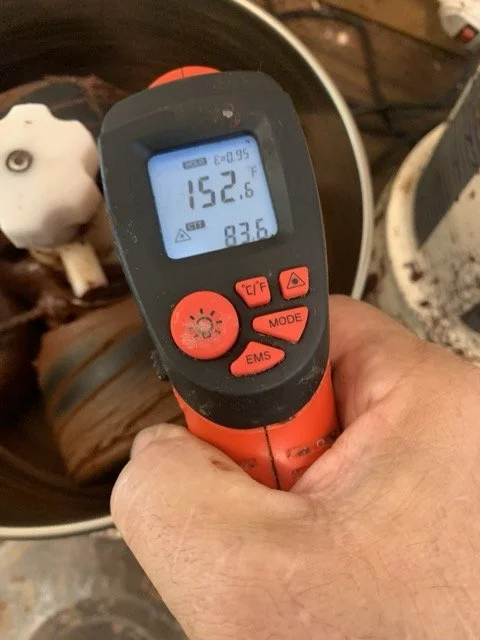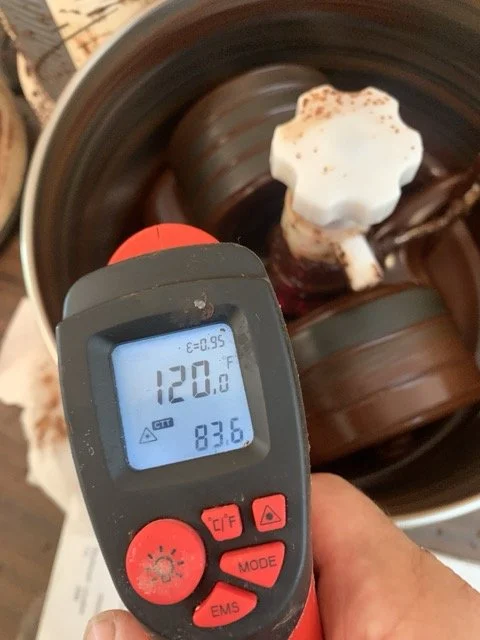Level: Apprentice
Read Time: 5 minutes
I’ve been making two ingredient chocolate a couple years now and notice my chocolate is much thicker than the chocolate I get from <censored>. I know my chocolate is superior but I can’t figure out what I can do to make it thinner without adding cocoa butter ruining the purity of my chocolate. Can you tell me how to make my chocolate like <censored> without adding extra ingredients?
Some days I wonder if you folks come up with these questions just to push my buttons and bait me. I’ll admit, I really considered ranting. And I started that way, noting that I found it kind of funny you considered your chocolate superior yet it had inferior handling ability to compared to something most people think is pretty good chocolate and handles well. I followed up with wondering what purity had to do with anything and that I find it stupid in the same way no one thinks adding a sauce to plain pasta is ruining its purity. No one whines that you are ruining the purity of an awesome steak when you add salt to it or grill it over a real wood fire to add flavor. By that logic, adding more water to high hydration artisan bread should be looked down upon because you are ruining the purity of the wheat buy doing something to heighten flavor, texture and pleasure. Adding cocoa butter to chocolate is not ruining its purity - it is allow YOU, the creator, the ability to make a product that works how you want it to work and taste like you taste it to taste. And I noted that it was selective bigotry that sugar is allowed, a highly processed product of modern life, but adding a titch more of something naturally occurring in cocoa beans is wrong? HUH? No adding salt or butter or milk to mashed potatoes!!! You will ruin their purity. Better yet, just don’t cook them, just eat them raw to preserve their purity. I very much wanted to say those things.
But I’m not going to say any of those things.
What I will say is that while I was giving my last roasting seminar I made a point that they needed to make sure to leave the roasted beans open to the air for at least 6 hours so moisture had time to fully escape and failure to do that could lead to extra thick chocolate. This is the whole reason we take pains to make sure water does not get into our chocolate. I went on to talk about that in another behind the scenes experiment I was doing I made sure to do the good scientist thing. To make sure my results were comparable to one another (was adding various amounts of water to raw beans to test mold and fungus growth <stay tuned, those tests are done and QUITE surprising>) I made sure to dry all the samples, including the roasted control. Why this came to mind is that the roasted control still dropped about 2% in weight when further dried.
When those two pieces of data clicked in my brain I thought of this question and had to put it to the test.
The hypothesis is that the residual water in fully roasted and properly cooled cocoa might be contributing to the viscosity of chocolate.
Viscosity is both complicated and not simple to measure. But I realized I didn’t really need to measure the viscosity or at least put a number to it. I just had to test if one chocolate was demonstratively thicker than another.
I realized I could probably make use of some of the advice I offer folks.
We all know by this point if you don’t have enough cocoa butter in your chocolate you are likely to have viscosity issues. The target I tell people to shoot for is a minimum of 35%. I’ve built a margin into that and in some cases you can have under 33% but rarely can you get to 30%.
That seems the perfect level to test. In theory, making a 60% chocolate (estimating 50% cocoa butter) would give a chocolate with 30% cocoa butter and would most likely be very thick, if it even refined at all. If moisture was playing any role, I figured I should be able to dry a set of the same nibs, removing that 2-3% moisture, and the resulting chocolate would be decisively less thick. So that is what I did.
I roasted up 3 kg of Peru Maranon, a bean that many people tend to report as being extra thick. Side note: I frankly think most people under roast it for fear of spoiling the purity of the cocoa, and instead leave too much water in the bean. I didn’t light roast like many do as the point of this test was properly roasted beans, not what to do if you leave too much moisture.
I winnowed the beans and put 1 kg to the side as the control and dried 1 kg for 6 hours at 150 F. The resulting nibs ended up weighing 974 g for a loss of 2.6% moisture, exactly in the range I wanted.
The recipe was just what I said before. 60% cocoa, 40% sugar, no extra cocoa butter.
I contemplated using the exact same recipe but realized if I did, I would be using technically more cocoa butter and it might skew the results so I decided to use the dry weight equivalent of cocoa (600*0.974) 584.4 g but the same amount of sugar. What that means is that I was using the same amount of cocoa butter but proportionally more sugar, so if it was less thick it would really show the effects moisture was having on the chocolate. The percent comes out to (584.4 / (584.4 + 400)) a 59.37% chocolate.
Control 60%
600 g roasted Peru Maranon cocoa nibs
400 g granulated sugar
Test Chocolate 59.37%
584.4 g roasted and dried Peru Maranon cocoa nibs
400 g granulated sugar
Gallery at the bottom of the post if you want to zoom in for detail
It is pretty obvious that the control was much thicker to the point of not viable. And if you are wondering if it might be because the room or chocolate was cool, check out the temperatures.
The Control
Dried Ingredients
That extra heat in the control is pure friction from a thicker chocolate.
The conclusion is obvious. Residual moisture in properly roasted and cooled beans can still significantly contribute to greater viscosity in two ingredient chocolate.
With extra cocoa butter, even as little as 5%, and the difference in viscosity of the two chocolates is virtually eliminated.
Rounding this out, I wanted to see if taste was impacted by the additional drying step and while I was at it I decided to test how the flavor was impacted when I added enough cocoa butter to bring the chocolate to a workable viscosity.
Half of each batch of chocolate was tempered with Silk and molded.
To the remaining chocolate, 50 g of cocoa butter were added, effectively raising the fat content roughly 10%.
A panel of 4 was set up to taste these blind for general comments and then with pointed questions.
For example, the control and test at ~60% were given and asked if the samples were the same or different chocolates. This was done a number of combinations control vs control, control vs test, etc so no result was expected.
It was determined no one could reliably tell the dried and un-dried samples apart.
Purity Duck
Unsurprising to me, but counter intuitive to many, the cocoa butter diluted chocolates were generally found to be more palatable and preferred and more than 2 of the 4 people thought they were sweeter, when in fact, due to the dilution, they were not. The explanation here is that the added butter allowed the chocolate to melt faster in the mouth, releasing more of flavor, faster, than the control.
There are a few more details that are worth discussing.
I tried drying a variety of dry ingredients like granulated sugar, milk powders and even cocoa butter and had no moisture to give up so you only need concern yourself with roasted nibs.
For the roasted nibs, although I used a drum roaster, further drying of all roasted nibs regardless of roasting method is going to be beneficial in reducing moisture to effectively zero.
Finally, you either want to put your dried nibs directly into a sealed container or start your chocolate with them immediately so they don’t reabsorb ambient humidity.
In conclusion, yes, you can indeed do something about excess thickness in your chocolate and doing so will not negatively affect the flavor of the chocolate. Likewise, the addition of cocoa butter may well positively improve both the taste and handling properties of your chocolate.
A win/win situation to me. Try it out and let me know how it works for you. Oh yeah, one more thing. Duck purity <wink>












